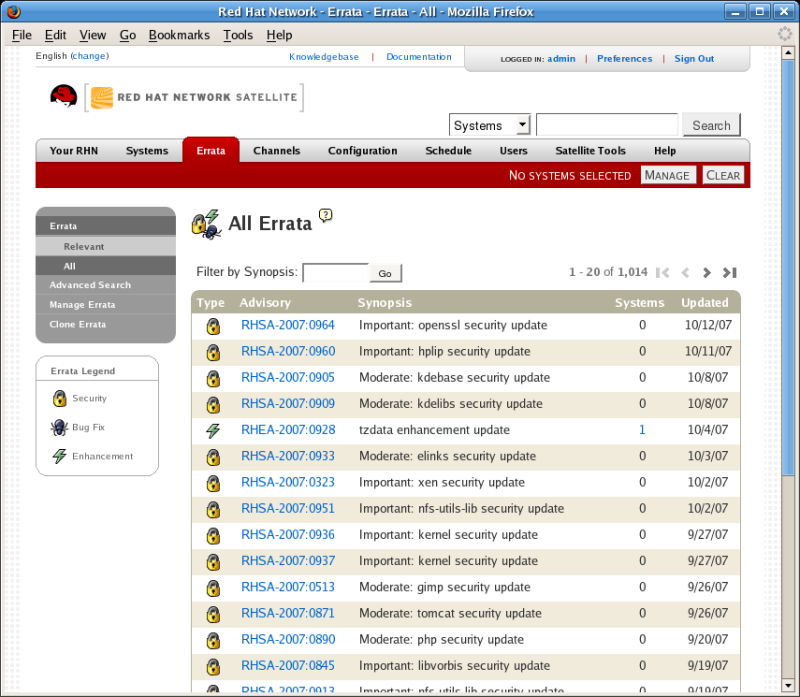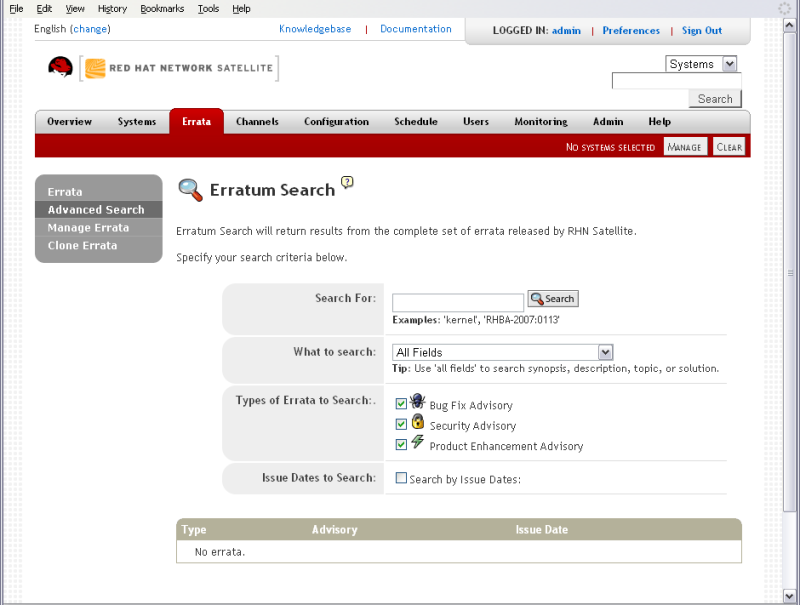7.5. Errata
Select the Errata tab from the top navigation bar to track the availability and application of errata to your managed systems.
The first page to appear here is the Errata Overview page. This page displays relevant errata, which are errata that apply to at least one system to which you have administrative access and that have not yet been applied.
Note
To receive an email when Errata Updates are issued for your system, go to Overview ⇒ Your Preferences and select Receive email notifications.
Red Hat releases Errata Updates in three categories, or types: Security Updates, Bug Fix Updates, and Enhancement Updates. Each Errata Update is comprised of a summary of the problem and the solution, including the RPM packages required to fix the problem.
Icons are used to identify the three types of Errata Updates:
 — Security Updates available, update strongly recommended
— Security Updates available, update strongly recommended
 — Bug Fix Updates available and recommended
— Bug Fix Updates available and recommended
 — Enhancement Updates available
— Enhancement Updates available
A summary of each erratum is provided in list form. This view instantly informs you of the type, severity (for Security Updates), and subject of the erratum, as well as the number of affected systems.
In addition to the pages described within this chapter, you may view Errata by product line from the following location: https://rhn.redhat.com/errata.
7.5.1. Relevant Errata
Copy linkLink copied to clipboard!
As shown in Figure 7.15, “Errata List”, the Relevant Errata page displays a customized list of Errata Updates that applies to your registered systems. The list provides a summary of each Errata Update, including its type, severity (for Security Updates), advisory number, synopsis, systems affected, and date updated.
Figure 7.15. Errata List
Clicking on the Advisory takes you to the Details tab of the Errata Details page. Clicking on the number of associated systems takes you to the Affected Systems tab of the Errata Details page. Refer to Section 7.5.2.2, “Errata Details” for more information.
7.5.2. All Errata
Copy linkLink copied to clipboard!
The All Errata page displays a list of all Errata Updates released by Red Hat. It works much the same as the Relevant Errata page in that clicking either the Advisory or the number of systems affected takes you to related tabs of the Errata Details page. Refer to Section 7.5.2.2, “Errata Details” for more information.
7.5.2.1. Apply Errata Updates
Copy linkLink copied to clipboard!
Errata Updates include a list of updated packages that are required to apply the Errata Update. To apply Errata Updates to a system, the system must be entitled.
Apply all applicable Errata Updates to a system by clicking on Systems ⇒ Systems in the top and left navigation bars. Click on the name of an entitled system, and click the Errata tab of the resulting System Details page. When the Relevant Errata list appears, click then the button on the bottom right-hand corner of the page. Only those Errata that have not been scheduled or were scheduled and failed or canceled are listed. Updates already pending are excluded from the list.
In addition, Management users can apply Errata Updates using two other methods:
- To apply a specific Errata Update to one or more systems, find the update within the Errata lists. In the table, click on the number of systems affected, which takes you to the Affected Systems tab of the Errata Details page. Select the individual systems to be updated and click the button. Double-check the systems to be updated on the confirmation page, then click the button.
- To apply more than one Errata Update to one or more systems, select the systems from a Systems list and click the button. Click the System Set Manager link in the left navigation bar, then click the Systems tab. After ensuring the appropriate systems are selected, click the Errata tab, select the Errata Updates to apply, and click the button. You can select to apply the Errata as soon as possible (the next time the Red Hat Network Daemon on the client systems connect to RHN) or schedule a date and time for the Errata Updates to occur. Then click the button. You can follow the progress of the Errata Updates through the Pending Actions list. Refer to Section 7.8, “Schedule” for more details.
Important
If you use scheduled package installation, the packages are installed via the RHN Daemon. You must enable the RHN Daemon on your systems. Refer to Chapter 5, Red Hat Network Daemon for more details.
The following rules apply to Errata Updates:
- Each package is a member of one or more channels. If a selected system is not subscribed to a channel containing the package, the package will not be installed on that system.
- If a newer version of the package is already on the system, the package will not be installed on that system.
- If an older version of the package is installed, the package will be upgraded.
7.5.2.2. Errata Details
Copy linkLink copied to clipboard!
If you click on the Advisory of an Errata Update in the Relevant or All pages, its Errata Details page appears. This page is further divided into the following tabs:
7.5.2.2.1. Errata Details ⇒ Details
Copy linkLink copied to clipboard!
This subtab displays the Erratum Report issued by Red Hat. It provides a synopsis of the erratum first, including the severity (for security updates), issue date, and any update dates. This is followed by brief and detailed descriptions of the erratum and the steps required to resolve the issue.
Below the Affected Channels label, all channels that contain the affected package are listed. Clicking on a channel name displays the Packages subtab of the Channel Details page for that channel. Refer to Section 7.6.1.9, “Software Channel Details” for more information.
Below Fixes, the specific Bugzilla entries resolved by this erratum are listed. Clicking on any summary text opens that Bugzilla entry at http://bugzilla.redhat.com. Note that you must have a Bugzilla account to view the entry.
Security updates list the specific vulnerability as tracked by http://cve.mitre.org. This information is listed below the CVEs label.
Red Hat provides security update information in OVAL format. OVAL is an open vulnerability and assessment language promoted by Mitre, http://oval.mitre.org. Clicking on the link below the Oval label downloads this information to your system.
7.5.2.2.2. Errata Details ⇒ Packages
Copy linkLink copied to clipboard!
Provides links to each of the updated RPMs broken down by channel. Clicking on the name of a package displays its Package Details page.
7.5.2.2.3. Errata Details ⇒ Affected Systems
Copy linkLink copied to clipboard!
Lists systems affected by the Errata Update. You can apply updates here. (See Section 7.5.2.1, “Apply Errata Updates”.) Clicking on the name of a system takes you to its System Details page. Refer to Section 7.4.2.9, “System Details” for more information.
To help users determine whether an update has been scheduled, a Status column exists within the affected systems table. Possible values are: None, Pending, Picked Up, Completed, and Failed. This column identifies only the latest action related to an Erratum. For instance, if an action fails and you reschedule it, this column shows the status of the Erratum as Pending (with no mention of the previous failure). Clicking a status other than None takes you to the Action Details page. This column corresponds to one on the Errata tab of the System Details page.
7.5.3. Advanced Search
Copy linkLink copied to clipboard!
The Erratum Search page allows you to search through Errata according to specific criteria.
Figure 7.16. Erratum Search
- All Fields — Search errata by synopsis, description, topic, or solution.
- Erratum Advisory — The way Red Hat Security Response Team codifies Advisories, such as:
RHBA-2007:0530
RHBA-2007:0530Copy to Clipboard Copied! Toggle word wrap Toggle overflow Searches can be by done year (such as 2007), by type of Advisory (RHBA for Bug fixes, RHEA for Enhancements, and RHSA for Security advisories), or full Advisory name, such as the example above. - Package Name — Users concerned with particular packages can search by package name, such as:
kernel
kernelCopy to Clipboard Copied! Toggle word wrap Toggle overflow Package search can be beneficial because search results will be grouped by advisory. For example, searching for kernel-related bugs return results where all packages with the termkernelappear grouped by the advisory for which the bug is related. - CVE Name — The name assigned to the Security advisory (RHSA) by the Common Vulnerabilities and Exposures project at http://cve.mitre.org. For example:
CVE-2006-4535
CVE-2006-4535Copy to Clipboard Copied! Toggle word wrap Toggle overflow
You may also filter errata search results by the type of errata issued. Check or uncheck the boxes next to the type of advisory to search.
- Bug Fix Advisory — Errata that contains fixes to issues that were reported by users or discovered during development or testing
- Security Advisory — Errata that fixes a security issue found during development, testing, or reported by users or a software security clearing house. A security advisory usually has one or more CVE names associated with each vulnerability found in each erratum.
- Product Enhancement Advisory — Errata that contains new features, improved functionality, or enhanced performance in the package's software.

